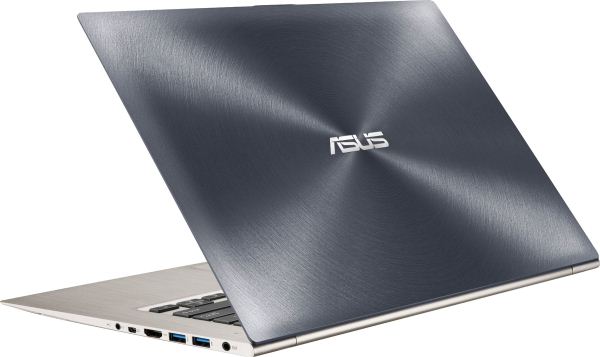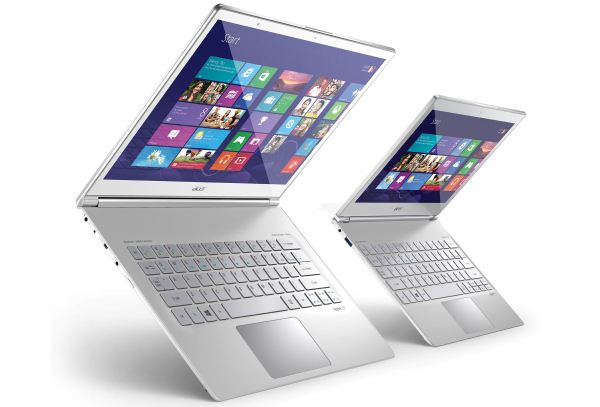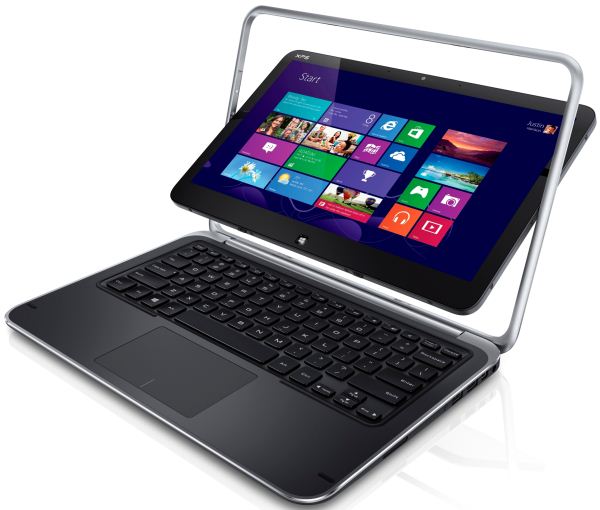Holiday 2012 Ultrabook and Ultraportable Guide
by Jarred Walton on December 12, 2012 4:00 AM ESTHigh-End Ultrabooks
Wrapping things up, we enter the final category of Ultrabooks and ultraportables, though these days we’re dealing almost exclusively with the former. In some cases we’re just getting the final high-end components from the previous category (Core i7 and 240/256GB SSDs), but there are a few other extras out there that might be worth the extra money. Let’s start with one of those.
High-End Ultrabook with Gaming Potential
The Acer M5 certainly packs a fairly potent CPU and GPU combination into an affordable package, but the overall quality of some elements is lacking. The display in particular is a sore spot, so what if you could get a similar laptop but with a 1080p IPS display? What you’d end up with is the ASUS UX32VD-DH71. It’s the big brother of the UX32A, which mostly means the display isn’t 1366x768 junk and you get a Core i7 CPU. You also get a GeForce GT 620M GPU, which actually isn’t all that fast, but it’s still probably twice the performance of the HD 4000 and you’re not as apt to throttle the CPU. Because of the design, you can also use standard 2.5” SSDs, making it possible to ditch the 500GB HDD and go for something faster. As noted earlier, Windows 8 is also shipping on the UX32VD now, so if you’re not keen on the new UI consider ClassicShell or Start8 as a good way to fix what MS broke. The UX32VD-DH71 currently sells for around $1300.
Hello 1080p Touchscreens!
At present, there are two 1080p Ultrabooks with touchscreens that I’m aware of, and we have them both in for testing. Each has some perks as well as a few quirks, so both are worthy of consideration.
Acer Aspire S7
I have to say, the first time you see the Aspire S7, you’ll very likely wonder if the Acer logo on the back isn’t a mistake. This is an extremely attractive laptop, and to my knowledge it’s the thinnest laptop anyone has ever shipped—it’s a whopping 0.47” (11.9mm) thick, which is in thick tablet territory! Acer’s 1080p display is good if not exceptional (colors are not anywhere close to accurate, though it’s at least reasonably bright), and you can go for either a Core i5-3317U with a 128GB SSD ($1300) or spend $350 more to get a Core i7-3517U with a 256GB SSD—actually, it’s technically two 64GB SSDs or two 128GB SSDs in RAID 0, which is one of the quirks. Anyway, if the $350 upsell sounds like highway robbery (it is!), we recommend the Core i5 model—95% of the performance, but with half the internal storage. One of the coolest things about both Windows 8 Ultrabooks that I’ve tested is that they can complete a full boot into the OS in about 10 seconds, and with the touchscreens the Windows 8 UI at least makes a bit of sense.
The biggest issues I have with the Aspire S7 (full review forthcoming) are the keyboard and the touchscreen. Starting with the latter, there’s no real issue as such, but reaching across the keyboard to touch the display feels a bit cumbersome. What the S7 needs is a way to turn into an actual tablet, like the Lenovo Yoga on the previous page or the Dell XPS 12 we’ll get to in a moment. You can lay the screen flat (180 degree hinge), but that’s not the same as a tablet. The keyboard is a far more irksome design, unfortunately, at least in my view. You see, I like to use keyboard shortcuts and that means using the function keys; Acer has chopped off the fifth row of keys, merging the function keys with the numbers. There are some other odd key locations as well, but the missing function keys is my biggest complaint. Given enough time I could probably adapt, but every other laptop and keyboard I use has function keys so it still frustrates me.
If Acer does a revised S7 in early 2013, changing the keyboard and creating a real tablet mode need to be at the top of their list. Pricing is also going to raise some eyebrows. I know people spend a lot of money on certain laptop brands, but those are generally business laptops or Apple products. I have a difficult time believing people will pay anywhere near $1300 for the base model S7-391, or $1200 for the 11.6” S7-191, regardless of how nice they look, simply because Acer’s brand lacks the necessary cachet.
Dell XPS 12
If you take all of the interesting points from the Acer S7 and fix the keyboard along with creating a workable tablet mode, you get the Dell XPS 12. This is actually one of the coolest laptops I’ve seen in some time, and while I was concerned about the “flip-screen” aspect holding up long-term when I first saw it, in hand the mechanism feels quite robust. Short of some abuse or an accident, the hinges feel like they’ll last many years. And that’s good, because the flip-screen is really cool. You can use the XPS 12 as a regular laptop, or you can flip the screen 180 degrees and close it, creating a tablet. One thing that’s very obvious is that the XPS 12 is quite a bit thicker than any Android or iOS tablets, but the Core i5/i7 Ivy Bridge processor at its heart is also substantially faster than any of the ARM or Atom parts we’ve seen elsewhere.
Besides the cool factor of the display, the XPS 12 comes in a variety of configurations. The base model has the 12.5" 1080p IPS panel, 4GB RAM, 128GB SSD, and an i5-3317U processor for $1200. Sadly, there’s no 8GB i5-3317U configuration, so the next step up gets you 8GB RAM and an i7-3517U for $1400—a $1250 configuration with just the 8GB RAM upgrade would have been perfect. Moving beyond that point, you can go back to the i5-3317U and get 8GB RAM, but you get a 256GB SSD, all for a starting price of $1500. Finally, there’s the no-holds-barred version that gives you the 8GB RAM, i7-3517U, and a 256GB SSD for $1700. I really like the design of the XPS 12, but the price gouging is enough to make me cry; $200 for a $25 RAM upgrade and a 100-200MHz CPU clock speed increase is laughable, and $200 to upgrade from a 128GB to a 256GB SSD is just as bad. But, if you want what is arguably the coolest Ultrabook around right now, that’s the price of entry.
Wrap-Up
This guide specifically focused on Ultrabooks and ultraportables, which eliminates a huge portion of the mobile market. We’ll look at doing other mobile guides in the coming days that get into the areas we’ve missed, including gaming laptops, other budget offerings, and even tablets. For now, we’ve listed about a dozen laptops that we could recommend for various reasons. Not every laptop would be a good fit for every person, but if you want something that’s easy to carry around—either for work, school, or some other reason—you should have several worthy options to consider. What did we miss, or do you have a converse opinion on any of our recommendations? Let us know in the comments!













77 Comments
View All Comments
EnzoFX - Wednesday, December 12, 2012 - link
What about build quality? Those cheap laptops are cheap for a reason. They'll last you maybe two years lol. Let alone the merits of portability and usability (What's the point of some bit laptop that you will hate using because it's built so cheaply and it has shitty kb/trackpad/screen, etc).kyuu - Wednesday, December 12, 2012 - link
What you say might hold some weight if other laptops had better battery life than expensive ultrabooks. They don't. Unless you're getting a sheet battery or a gigantic battery that bulges out the bottom.Also, ULV chips really perform pretty much on par with standard laptop chips. I did some research on a particular ULV i5 that was in an ultraportable (though not quite an ultrabook) versus the standard LV i5 that was also an option. My finding was that the ULV i5 had pretty much equal performance in all respects to the standard LV i5, it just drew less power and had a price premium. Not really surprising considering ULVs are generally the same chips as the standard ones, they're just binned to get the ones that run at lower voltages.
SetiroN - Wednesday, December 12, 2012 - link
I'm not using the MBA as an example, we're talking ultrabooks. Apple's ultraportable admittedly is a better option, but no ultrabook is on par with it on multiple sides so considering were're talking ultrabooks, I couldn't care less that you're posting from your macbook air (as if the idiotic smartphone tapatalk signatures weren't enough, btw).As I said, I have an UX31A (the top version with the 1080p screen, i7 and 256Gb SSD), and it's nowhere near worth the price premium.
- the screen is good, but it's a common e-IPS that's not worth $500. Also, 1080p is overkill (and 16:9 is just stupid at small diagonals, give me a freakin' 16:10 display FFS) and not prone to desktop usage
- the ULV i7 performs well, but it's not better than a normal voltage i3 3110m. I find myself limiting the CPU frequency on the go to retain that 1 more hour of battery and I could achieve exactly the same with said i3: at their low power states, 800-1200MHz, they run at the same voltage and consume the same amount of power, something I hadn't considered before
- build quality isn't all that good: the hinge becomes slightly loose over time and the screen gets damaged over contact with the keyboard border when closed). Yeah, it's made out of an aluminium unibody, but it's absolutely not solid, it easily bends and honestly compares to a normal plastic chassis. Macbooks' sturdiness is way above this
- the trackpad SUCKS
- despite the ULV chip, it's still relatively noisy under even slight load
-at 1.4Kg and 18mm, it's not that much more portable than normal 1.8Kg 25mm 13inchers
And that's arguably the best ultrabook on the market I'm talking about here.
So yeah, current ultrabooks are all about style and milking customers.
Unfortunatly Intel and the industry are pushing towards them enough that the great alternative that could easily be possible nowadays doesn't exist.
A more average 13" chassis (Thinkpad 430, Vaio 13s) has equal or better quality than this Asus ultrabook and could easily pack a configuration such as this:
1600x900 non-TN screen
i3 3120m
GF 620m or better
70Wh battery
128GB mSATA SSD + 2,5" HDD
for $700 less than the $1500 I paid for my ultrabook
But no, manufacturers need to follow fashion, stay within Intel's ultrabook specs and push pricey stylish designs, leaving consumers without a smarter option to buy.
Shadowmage - Wednesday, December 12, 2012 - link
I have a Lenovo Yoga, which I bought for $825 shipped off Amazon. It has a 1600x900 13" IPS touchscreen, high quality Lenovo keyboard, and quite decent touchpad. Also, it weighs around 3.4lb and 17mm thin.A Thinkpad T430 costs just a hundred dollars less and is more than 1lb heavier, a larger form factor (14" vs 13"), and doesn't have the touchscreen (which is surprisingly useful).
It's not form over function, this is actually a best-in-class machine.
arswihart - Thursday, December 13, 2012 - link
The trackpad rocks on the UX31A with the latest non-Asus Elantech drivers (I forget the driver number). I use them along with Google TouchFreeze (disables touchpad when typing), and I'm extremely happy with the touchpad.The ASUS touchpad drivers worsen accuracy and sensitivity. They fool you into upgrading to them by incrementing Elantech's driver version number, as if Elantech developed the drivers. Instead, ASUS is hacking on them and making them worse.
Personally I love my UX31A, if you don't need a bunch of CPU power and can deal with the 4GB RAM, it's really a beautiful device with a display that is second to none. Battery life is acceptable but agreed it's not great.
arswihart - Thursday, December 13, 2012 - link
I agree the model you bought (i7 with 256GB SSD) is a waste of money. The base model has essentially identical performance and is a few hundred bucks cheaper.So, I can see how the UX31A sucks for people like you who bought the expensive version.
JNo - Wednesday, December 12, 2012 - link
"I'm not sure what post you've read, but nowhere did I say I needed more performance or heavy graphics."But you did say:
"I'd much rather have a standard i3 (which performs better) than those overpriced ULV cpus, in a thicker laptop that takes advantage of it with a seriously hefty battery and acceptable dedicated, switchable graphics."
You may not have shouted it out directly but I think most would agree that any normal person would infer that you actually find your ultrabook lacking at times and could appreciate some more grunt. You may not *need* it but there' s an implication that it wouldn't go amiss. Maybe you should read your own post more carefully before getting too snarky in your reply...
SetiroN - Wednesday, December 12, 2012 - link
You're right, I apologise for coming out too sour.JarredWalton - Thursday, December 13, 2012 - link
Hey, what do you think you're doing!? This is the Internet. You NEVER, EVER apologize on the Internet! Man, when will people ever learn?;-)
althaz - Thursday, December 13, 2012 - link
No, you pay for portability, screen quality, build quality and battery life. As an added bonus you can pretty frequently also get a huge boost to everyday speed and performance with an included SSD (the best thing about ultrabooks).I don't give a shit about graphics in my portable PC (the HD4000 is no slouch, btw, it's not the integrated graphics of old), I've got a desktop with a 4Ghz i5 and OC'ed GTX670 with 16Gb of RAM for when I want performance.
I can't take my desktop on the train though. But with an ultrabook (I'll be picking one up that is also decent as a tablet as well, thinking the Samsung transformer-esque model with ULV i5 and 128Gb SSD) I can do my University assignments on the train (I work full-time so it's the perfect opportunity to get stuff done) and I can take it hiking or camping as well as watch a movie or read an e-book with it at home. I can also browse the web whilst sitting on the couch or catch up on my work emails while I'm on a plane.
Laptops are universally rubbish for performance, so why not get one that is ACTUALLY portable?